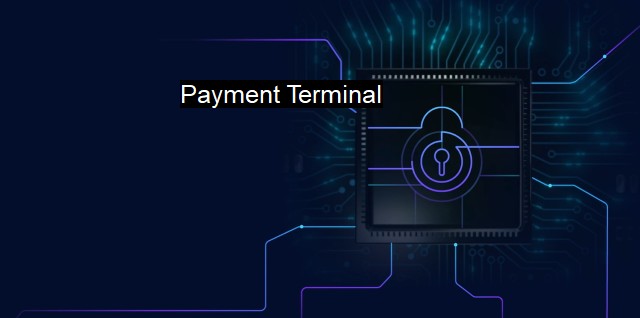What is Payment Terminal?
Exploring Payment Terminals: Types, Risks, and Future Trends in the Electronic Payment Landscape
A payment terminal, also referred to as a Point of Sale (POS) terminal, card terminal, or EFTPOS terminal, is a device that executes transactions via debit or credit cards to make cashless payments for goods or services. These terminals encompass an array of electronic software and hardware, including pin pads, card readers and contactless payment technologies. They have become ubiquitous in our modern high-tech infrastructure, found in supermarkets, retail outlets and restaurants alike.With the continued growth and evolution in technology, cybersecurity threats have been amplified, painting the communication between technologies as a lucrative target for hackers. Therefore, securing payment terminals has not just become a luxury, but a necessity mandated by The Payment Card Industry Data Security Standard (PCI DSS). This reflects on the critical importance of cybersecurity within context of payment terminals.
Think of a payment terminal as a distribution avenue that processes complex modes of cashless transactions between various cybersecurity layers. These layers include consumers, merchants, financial institutions, and third-party service providers. Each step of the transaction involves encoding, secure transmission and authentication. in order to mitigate the risks of counterfeit card abuse, an encryption system known as Europay, Mastercard And Visa (EMV) is often set in place.
How does cybersecurity work within this context? It gears towards establishing a control system wherever customer data is at risk of being abused. If a system is compromised and a data encryption method is not effective, unencrypted card details are relatively easy to be abused forexploitative purposes. With efficient encryption, stolen data becomes unreadable, turning it into nonsensical symbols and codes.
One common example is point-to-point encryption (P2PE). This technology converts the critical card data into encrypted code at the point of sale terminal, before any software or segment of the merchant system can have access to it. Only the decryption system is able to convert this chaotic assemblage of data back into a usable, sensible data format.
Another essential security technology is tokenization, which replaces sensitive data with a concrete nonsensitive equivalent, referred to as a token. The importance of tokenization is underlined when considering that it is impossible to reverse tokens to their original data without the decryption key. if a cybercriminal tries to intercept transactions carried through a tokenized payment terminal, they will upon data theft, find non-breachable tokens that have zero worth.
Today, payment terminals need antivirus protection just like any computer or device connected to the internet. Sophisticated malware and ransomware are capable of infecting terminals, leading to compromised data protection, That's why a technical antivirus solution is equally critical here. It prevents any malicious software from bypassing terminal protections and safeguards the entire transaction process.
Payment terminal security involves an array of technologies, from those on the merchant level for controlling physical and logical access to the terminal, up to highly specialized endpoint security solutions that detect and respond to anomalies in the transaction data.
Maintaining a secure payment site is not a one-time process. It involves the implementation and persistent update of plans and proves compliance with industry standards. This can only be achieved through a combination of both hardware and software cybersecurity measures, personal vigilance, strict protocols and advanced technology suites. As businesses are becoming more digital in their transaction methods, the task becomes to equip their payment even greater layers of protection for ever-adapting cybersecurity needs.
Payment terminals represent a high-tech highway for globalization-driven cashless transactions. Guarding this highway against cybercriminals breeds the need for predictive analysis tools, strong encryption, tokenization and effective antivirus software solutions. Cybersecurity technologies intertwine with the payment terminal ecosystem to protect the integrity, confidentiality and accessibility of cardholder data at every layer.

Payment Terminal FAQs
What is a payment terminal?
A payment terminal, also known as a point-of-sale terminal, is an electronic device used to process electronic transactions, such as credit card, debit card, and mobile payments, at retail locations.How do payment terminals relate to cybersecurity?
Payment terminals are a common target for cybercriminals seeking to steal payment card data. Therefore, securing payment terminals is essential to protect against payment fraud and data breaches.What is an antivirus solution for payment terminals?
An antivirus solution for payment terminals is a software program designed to detect and remove malware, viruses, and other harmful files that may compromise the security of payment transactions processed through the terminal.How can I ensure the security of my payment terminal?
To ensure the security of your payment terminal, you should implement strong password policies, keep your payment software up to date with the latest patches, and regularly conduct security assessments to identify and fix any vulnerabilities. Additionally, it is recommended to use an antivirus solution for added protection against malware and other threats.| | A | | | B | | | C | | | D | | | E | | | F | | | G | | | H | | | I | | | J | | | K | | | L | | | M | |
| | N | | | O | | | P | | | Q | | | R | | | S | | | T | | | U | | | V | | | W | | | X | | | Y | | | Z | |
| | 1 | | | 2 | | | 3 | | | 4 | | | 7 | | | 8 | | |||||||